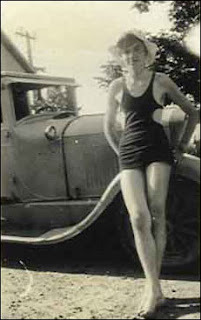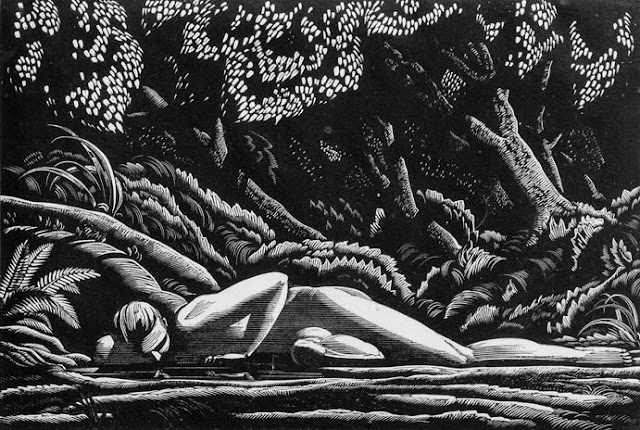 |
New York : Farrar, Straus and Young, 1952
|
“All day Sunday on the road, and in spite of his absorbed self-analysis, he had been unable not to watch the travelers on the road. Where were all these people going? The relation of people-Americans-to their automobiles (the way he felt about his own car, the manner in which it seemed to endow him with special importance as a person as if it were an extension of himself, a necessary adjunct to his ego) intrigued him. It seemed to him-and again he felt a sense of discovery-that it was a material representation of enormous magnitude: the cult of the machine-the automobile-had replaced faith. The road, leading endlessly and relentlessly on, a pathway to the unknown, the unexperienced, the future, was capable of leading him anywhere. If there was a heaven for Americans, it would be on such a road, at the top of a rise; something that would be reached in a car."
-The Descent, p.182-3
![FROM TOP TO BOTTOM: [1] (Review Edition) New York : Farrar, Straus and Young, 1952 [2] New York : Signet/NAL, 1953 [3] (As Descent to Darkness) New York : Berkley Publishing Corp, 1959 FROM TOP TO BOTTOM: [1] (Review Edition) New York : Farrar, Straus and Young, 1952 [2] New York : Signet/NAL, 1953 [3] (As Descent to Darkness) New York : Berkley Publishing Corp, 1959](https://blogger.googleusercontent.com/img/b/R29vZ2xl/AVvXsEhrS3HQq_j2dErLqTBql3ydjhtF_JcUKr5oCfRJ6FM277G19nJbs3x-GMd514cVj2NXWnKs9DXeRxNpfeiIlheyZs374yzFxFTzxcouxvKQhxlY55qS8dE4r7o6DOLc1QlD6DNouaZ_-18/s640/desc52rev%252B53%252B59.jpeg) |
FROM TOP TO BOTTOM:
[1] (Review Edition) New
York : Farrar, Straus and
Young, 1952 [2] New York :
Signet/NAL, 1953 [3] (As
Descent to Darkness) New
York : Berkley Publishing
Corp, 1959
|
While correcting the final galley proofs for Finistère, Fritz Peters was already hard at work on his third novel. While staying with friends in Clinton, New York, he had begun his research for a novel that takes place on the roads and highways of the United States. He began by observing and interviewing drivers traveling Route 20 in New York, asking the question "Where are we all going?"
The Descent tells the stories of people from all over the country, bringing them together at one crucial moment on a highway in New Mexico. Each individual's experience and choices brings them to this place and time.
Peter Wells is leaving Three Bridges New York, headed to California to be a screenwriter. He's unsure of why he is going and is worried about his father's ill health.
Steven Williams of New York feels smothered by his wife Marjorie, quits his job and begins a cross-country trip, headed toward Santa Fe.
Henry and Mabel Franklin are in a miserable marriage, where Mabel is in charge and believes that Henry is a miserable excuse for a husband. Each year, they take a vacation together, but this year may be the year that Henry finds his voice.
Bob & Mary Hume are on an extended camping vacation in the Southwest with their two children, Toby and Emily. Bob seems to be the only one enjoying himself, but will Mary say anything to him? The children have ideas about what they would like to do, but will their parents listen?
Caroline Pratt has picked up Tom Foster. She's a rich girl who wants to shock her parents by her reckless behavior of picking up a one-night stand. She is desperate to keep Tom around, though, and will do anything to keep him.
Richard Simms is an artist in Santa Fe. His wife Dorothy manages Richard's mother's properties, including the ones that she gave Richard to help support him. Richard begins to doubt his talent as a artist and the tension in the house increases.
Jim Curran, a veteran of WWII, has no job, but rents an apartment behind the Simms' house with his government check. Now that the United States is fighting in Korea, he feels people no longer care about the veterans of previous wars and his sadistic nature begins to emerge.
This post originally appeared on FritzPeters.info, February 1, 2009.








































![FROM TOP TO BOTTOM: [1] (Review Edition) New York : Farrar, Straus and Young, 1952 [2] New York : Signet/NAL, 1953 [3] (As Descent to Darkness) New York : Berkley Publishing Corp, 1959 FROM TOP TO BOTTOM: [1] (Review Edition) New York : Farrar, Straus and Young, 1952 [2] New York : Signet/NAL, 1953 [3] (As Descent to Darkness) New York : Berkley Publishing Corp, 1959](https://blogger.googleusercontent.com/img/b/R29vZ2xl/AVvXsEhrS3HQq_j2dErLqTBql3ydjhtF_JcUKr5oCfRJ6FM277G19nJbs3x-GMd514cVj2NXWnKs9DXeRxNpfeiIlheyZs374yzFxFTzxcouxvKQhxlY55qS8dE4r7o6DOLc1QlD6DNouaZ_-18/s640/desc52rev%252B53%252B59.jpeg)









































